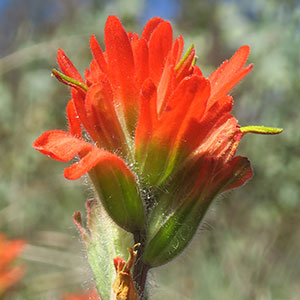Castilleja brevilobata
Castilleja cusickii
short-lobed paintbrush
Cusick's Indian paintbrush, Cusick's paintbrush
solitary or few, erect or ascending, unbranched, sometimes branched, hairs spreading, short, medium, and long, soft, short and medium ones short stipitate-glandular.
solitary or few to several, erect, often decumbent at base, unbranched, sometimes branched, hairs spreading, long, soft, eglandular, mixed with shorter, sometimes stiff, stipitate-glandular ones.
green or ± yellow, lanceolate, elliptic, or oblong to narrowly ovate, 1–2(–2.5) cm, not fleshy, margins plane or wavy, involute, (0–)3–5(–7)-lobed, apex rounded to acute;
lobes ascending to erect, linear to lanceolate, apex rounded to acute.
green, sometimes with prominent red-purple veins, lanceolate-linear to broadly lanceolate, 2.5–4.5(–7) cm, not fleshy, margins plane, flat, (0–)3–5(–9)-lobed, apex acuminate to acute;
lobes spreading-ascending, narrowly lanceolate, arising at or above mid length, apex acute.
3–20 × 2–3.5 cm;
bracts proximally greenish to dull brown, distally red, orange-red, or scarlet, sometimes orange or yellow, broadly lanceolate or oblong, (0–)3–5-lobed;
lobes ascending, broadly to narrowly lanceolate, short, arising above mid length, apex acute, obtuse, or rounded.
3.5–26 × 1.5–3.5 cm;
bracts pale green, pale greenish yellow, or pale yellow throughout, or proximally pale green, pale greenish yellow, pale yellow, or reddish purple, distally white, yellow, pink, dull purple, or dull reddish purple, sometimes with a purple band below that, sometimes with veins darker than background color, lanceolate to oblong, 0–5(–9)-lobed;
lobes ascending or spreading, linear to narrowly lanceolate, often short, arising above mid length, central lobe apex rounded, lateral ones acute to rounded.
straight, 15–24(–26) mm;
tube 12–16 mm;
beak exserted, abaxial lip equal to calyx;
beak adaxially green or ± yellow-green, 7–10 mm, puberulent, stipitate-glandular;
abaxial lip deep green, reduced, rounded, 1–2 mm, 10–25% as long as beak;
teeth incurved to erect, light green, 0.5–1 mm.
straight, 19–25(–28) mm;
tube (13–)15–20 mm;
abaxial lip included, beak not or slightly exserted;
beak adaxially green to yellow-green, 4–7 mm;
abaxial lip yellow, prominent, inflated, 2–4.5 mm, ca. 75% as long as beak;
teeth incurved to erect, white, 1.3–2.1 mm.
green or whitish with green veins, lobes colored as bract lobes or paler, 14–30 mm;
abaxial and adaxial clefts 5.5–8.5 mm, 30–40% of calyx length, deeper than laterals, lateral 1.5–4 mm, 20–25% of calyx length;
lobes oblong to narrowly triangular, apex obtuse to rounded.
green, pale green, or pale yellow, lobes yellow to pale yellow, 20–30 mm;
abaxial and adaxial clefts 6.6–14 mm, 33–50% of calyx length, deeper than laterals, lateral 0–4(–4.5) mm, 0–15% of calyx length;
lobes broadly rounded to triangular, apex obtuse to rounded.
= 24.
= 24.
Castilleja brevilobata
Castilleja cusickii
Castilleja brevilobata is endemic to dry serpentine openings in the Siskiyou Mountains of southwestern Oregon and adjacent California. Although sometimes treated as part of C. applegatei or C. hispida, its morphology does not suggest a close connection with either. This species occasionally hybridizes with C. pruinosa in Del Norte County, California.
(Discussion copyrighted by Flora of North America; reprinted with permission.)
Castilleja cusickii includes two morphologically distinct variants. One variant has a wider inflorescence, broader bracts, and wider bract lobes. These bracts often have highly contrasting purple veins, and some populations also have a purplish wash on the bracts. These plants have a range on the western edge of typical C. cusickii, though overlapping with more typical forms in western Idaho and adjacent northeastern Oregon and southeastern Washington. The name C. lutea is available for these variants, and both consistent morphological differences and preliminary results from ongoing genetic research on the plants (D. C. Tank, pers. comm.) indicate its resurrection may be justified. A second variant is distinguished by a pale pink-purple wash on the bracts and a narrow distribution in the meadows of the Bear River Valley, bordering northwestern Utah and adjacent southeastern Idaho. Only bract coloration appears to distinguish this form from typical C. cusickii, and the distinctive bract coloration is only more or less consistent in these populations.
Typical Castilleja cusickii appears to hybridize with C. gracillima in the Logan Valley, Grant County, Oregon. It is also reported by M. Ownbey (1959) to hybridize with C. miniata and C. rhexiifolia.
(Discussion copyrighted by Flora of North America; reprinted with permission.)


